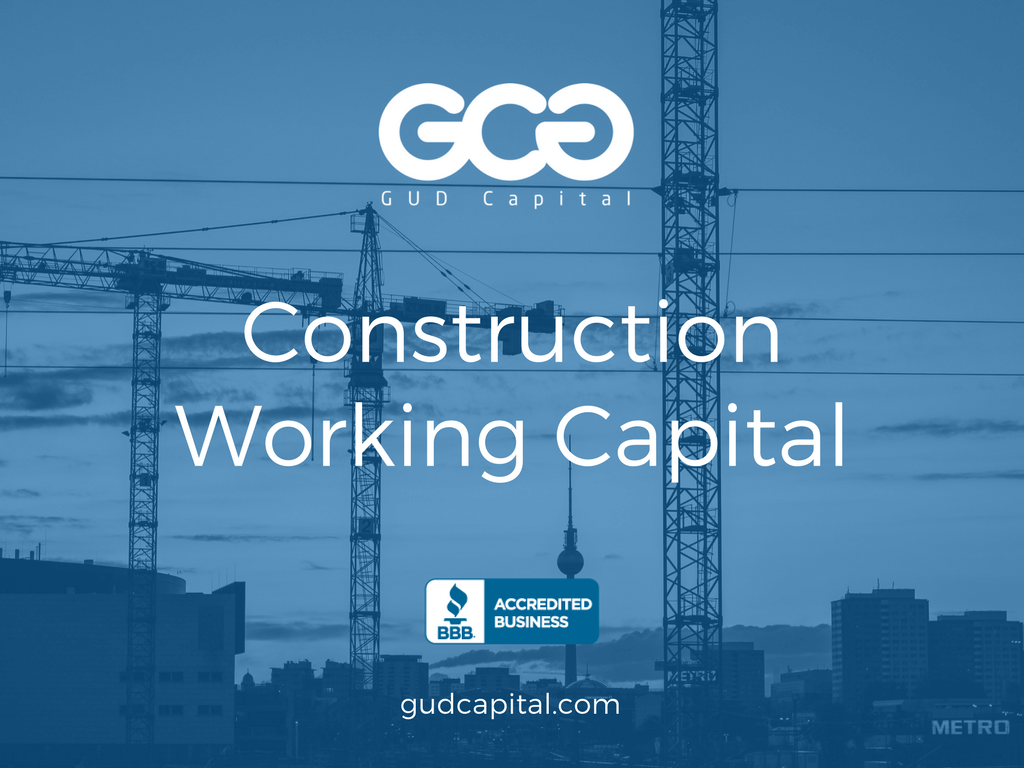Construction Operating Capital
The construction industry is rapidly growing as new advances in technology, and consumer demand continues to shape the market. Renters, homeowners and businesses alike are displaying interest in new and innovative trends that will affect how the construction industry is conducted and progresses. Within every sector of construction, that being; roads, highways, and other infrastructures, change, and innovation has happened in 2017. For those not too familiar with development and all that it encompasses, it consists of all businesses that build houses, office buildings or highways and bridges as well as those who do specialized work, such as electricians or plumbers. As follows, the construction industry remains to be a significant part of our economy as it continues to grow with influences from new trends like modular buildings, drones, Building Information Modeling (BIM), Internet of Things (loT), and staying green just to name a few. These are all essential elements needed to thrive and stay ahead of the game in the construction industry.
One of the more interesting and slightly surprising has to be modular buildings. In the past few years’ modular buildings and houses have gained a following and are in demand like never before. Even pack-your-own-home has been gaining a following from supporters of real estate and construction industries, and in particular, young professionals are one of the many groups that are continually moving from one place to another making this trend especially appealing to them. Though, these changes are not necessarily happening in unoccupied metro areas, but, in remote locations and suburbs, places more in tune with nature. Modular homes also have advantages such as being devolved off-site, thus reducing the impact to the original landscape, more efficient, reduces the risk of incidents, cheaper to build, provides a faster way to develop residential areas, and build times are shorter. Believe it or not, some builders are even offering to get your house on a semi, providing you with the option to move it around from city to city as you relocate. Ultimately, modular buildings have proven to be the trend that has offered the most significant safety and time advantages.
Although, one of the coolest and technologically advanced trends that have come to contribute to the growth in the construction industry are drones. They can access remote locations, are equipped with cameras, can collect data, capture project progress, and complete safety inspections, and much more. So surveyors; a technique used by professionals that determine the three-dimensional positions of points and the distances and angles between them. They, in turn, use the drones to create 3d mapping or images that can be used later to depict an area. They have come to be one of the most critical trends in the construction industry.
However, there is one innovation that has served as an excellent tool for increasing effectiveness and collaboration; BIM. The Building Information Modeling has become so influential in the industry, that it is now a part of the standard scope for many government agencies and other companies interested in knowing beforehand issues and the construction projects that they will face. BIM also aids in reducing production costs as it promotes safer and faster construction and minimizes safety incidents. What also is contributing to effectiveness and productivity, is the Internet of Things (loT). Understanding that these days, everything is about the internet and data moving across the web, loT has allowed for an increase in productivity using the tools we already have. These include, communication, collaboration, logistics, inventory, time tracking, photos, data, docs, and tool detection, are among the ways builders are utilizing technology to benefit their projects and increase productivity.
Lastly, in 2017 ever construction project is expected to be more sustainable environmentally and to aim towards meeting the expectations of the LEED; stands for the Leadership in Energy and Environment Design and was developed to measure the sustainability and performance of a building. To elaborate, what makes a material, “green” is operating cost and what the components add to the environment. Nevertheless, going green is more effortless than ever before with the innovations in sustainable and reusable materials. Plus, the benefits of going green include lower costs, in part due to growing competition has helped lower the amount of money required to acquire the correct materials, and use green construction methods. Now, due to increased demand and competition, the previously expensive green materials are a reasonable price in comparison to traditional construction. However, the most eco-friendly material has come to be steel and is a crucial element to thriving and investing in the construction industry. For one, steel is highly durable and can last for decades. Once it is no longer usable, steel can be recycled from old construction with no need to mine metal or leave waste in a landfill. As you can see, the construction industry has numerous trends from new and exciting technology to getting back to nature thus they all are essential to know and understand to succeed and last in the construction industry.

Types of Construction and Subcontractor Working Capital
When it comes to the construction industry, having sufficient working capital to keep projects going, or to cover your costs during downtime and between projects is crucial to keeping your suppliers and employees happy. Its crucial that construction companies keep their employees working and collecting paychecks to ensure you keep your best talent. Below we will take a look at the difference working capital financing options available to construction companies, contractors and subcontractors.
SBA Construction Working Capital
The Small Business Administration offers a loan guarantee programs to small businesses seeking affordable working capital who have good credit and revenue, but have been unable to get their working capital loan approved from a conventional lender. The main SBA program used for working capital terms loans is the general SBA 7(a) loan program. Within the SBA 7(a) program is the SBA Express program which offers both term loans and lines of credit.
| Rates | 5-8% |
|---|---|
| Terms | 3-25 years |
| Funding Amounts | $50,000-$5,000,000 |
| Collateral | Required |
| Fees | Medium costs |
Bank Working Capital
Conventional lenders (large banks, small banks, credit unions and non-profit community lenders) offer the lowest rates and longest terms for construction company working capital. Additionally, traditional lenders have the lowest fees of all commercial working capital lenders. But, traditional lenders can only offer such low-cost financing because they won’t expose themselves to much risk. Therefore, if you’re seeking a loan for working capital from a conventional lender, you will need fantastic credit and show the ability to service- the-debt with ease.
| Rates | 5-10% |
|---|---|
| Terms | 1-30 years |
| Funding Amounts | $50,000-$5,000,000 |
| Collateral | Required |
| Fees | Medium costs |
Line of Credit
Lines of credit are a great financing tool for construction companies and subcontractors seeking a great form of working capital to help with business operations. Having access to readily available capital without having to seek further authorization from the bank or commercial lender is especially convenient for construction companies having to wait 30-90 days for payments. The most common lenders that provide lines of credit are banks, credit unions, asset based lenders, SBA lenders and unsecured business lenders.
| Rates | 8-15% |
|---|---|
| Terms | 1-3 years |
| Funding Amounts | $5,000-$5,000,000 |
| Collateral | Required |
| Fees | Medium costs |
Factoring
This form of alternative financing is perfect for construction companies needing shorter-term working capital who have large accounts receivables they are waiting to get paid on. Factoring involves the selling of such receivables to a factoring company, and receiving an upfront payment. Since this involves the sale of the receivables it is not a loan but, instead, a business-to-business transaction.
| Rates | 1-3% monthly |
|---|---|
| Terms | 1-2 years |
| Funding Amounts | $100,000-$5,000,000 |
| Collateral | Required |
| Fees | Medium costs |
Accounts Receivable Financing
Accounts receivable financing is similar to factoring in that the accounts receivables are used as the basis for financing. Where factoring and AR financing differ is that with accounts receivable financing, the AR isn’t being sold. Instead, the accounts receivables is used as collateral for as an asset based line of credit. The AR is constantly monitored to make sure that the line of credit is sustainable, and is adjusted accordingly.
| Rates | 1-2% monthly |
|---|---|
| Terms | 1-2 years |
| Funding Amounts | $100,000-$5,000,000 |
| Collateral | Required |
| Fees | Medium costs |
Asset Based Working Capital
If your construction company has been unable to get approved for a working capital loan or line of credit using more conventional means because of issues related to revenue, another option to be to get a loan using your business or personal assets. Asset based loans work by tapping into the equity in your business’s balance sheet through collateralizing commercial real estate, accounts receivables, equipment & machinery, or even inventory. By using this collateral for high-risk working capital, the lender is able to help mitigate their losses should the borrower default.
| Rates | 8-25% |
|---|---|
| Terms | 1-3 years |
| Funding Amounts | $100,000-$5,000,000 |
| Collateral | Required |
| Fees | Medium costs |
Cash Advance Working Capital
Construction company cash advances are the fastest and easiest financing method for a construction business or subcontractor to obtain immediate business capital without the hassles that you must go through getting approved from every other type of commercial financing company. A business cash advance is much like factoring in that it involves the purchasing of future receivables. The difference is that a MCA involves the sale of future bank account receivables. Additionally, the way the repayment is made differs in that a merchant cash advance is repaid by having a set amount sent to the funding company each business day through Automated Clearing House transaction from your construction company’s main operating bank account.
| Factor rates | 1.10 – 1.50 |
|---|---|
| Terms | 3-24 months |
| Funding Amounts | $5,000-$2,000,000 |
| Collateral | Not required |
| Fees | High costs |
Summary
As we mentioned earlier, we understand that construction companies are constantly in need of capital to pay suppliers and employees. Making payroll is the most important focus of most companies, and especially with the construction industry. If you are a construction company in seeking working capital to help cover expenses, please reach-out to one of our working capital specialists, and we will help you navigate the funding process.





















